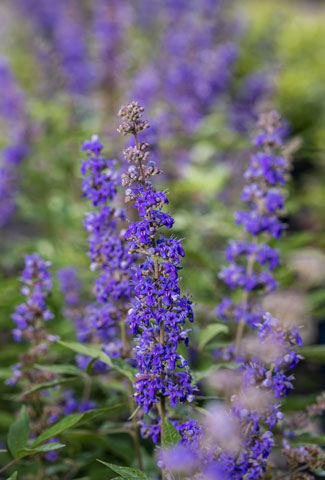1/1/2024
Queen Bee: A New Kind of Shrub
David Roberts

First Editions Queen Bee Chastetree is the newest vitex cultivar developed by the Georgia-based plant breeding program at Bailey Innovations. Queen Bee was bred near Athens, Georgia, and was selected for its restrained habit, its propensity to rebloom, and its improved cultural and environmental tolerances.
While most vitex can reach heights of 15- to 20-ft. tall, Queen Bee is a naturally rounded shrub about half the size of traditional vitex. The original Queen Bee is approximately 6-ft. tall by 6.5-ft. wide and has been grown in-ground, unpruned, for the last six years.
Queen Bee is the earliest flowering vitex we’ve ever observed, with blooms emerging at the beginning of June and continuing through October. Queen Bee will naturally rebloom throughout the growing season, but it will explode with new blooms if a grower or gardener performs a mid-season deadhead.
While Queen Bee will do exceptionally well in Zones 6 to 10, we’ve witnessed this hardy vitex survive multiple winters in Illinois, where temperatures reached -10F (-23C). Queen Bee has even survived in Minnesota, where the temperature reached -22F (-30C)! Anytime temperatures get that low, stem dieback is inevitable, but Queen Bee will regrow from the crown and produce big, beautiful blooms just in time for summer.
Propagation/Production
Cuttings: Propagules are typically collected from late June through early July. Cuttings are 2- to 4-in. long and usually consist of at least two nodes. The lower node is stripped of leaves and the upper node’s leaves are trimmed back by a third to reduce as much surface area as possible. The stripped end of the propagule is treated with 3,000 ppm Hortus IBA, water-soluble salts and stuck appx. 1-in. deep in 38 cell trays. Rooting percentages are relatively high, yielding around 90% take.
Media
Liner media: 38-cell trays are filled with Sunshine Mix #4, Professional Growing Mix. Harrell’s 17-5-11 polyon, six to seven month controlled-release fertilizer is incorporated at a rate of approximately 6 lbs./cu. yd. of substrate.
Container media: In Georgia, container substrate is 85% pine bark and approximately 15% organic matter with micronutrients incorporated. Lime is added to adjust pH to a relatively neutral range.
Irrigation
Liner irrigation: Irrigation can be one of the more nuanced aspects of vitex propagation. If there’s one thing to remember, vitex don’t like their leaves to stay wet for too long. Upon first sticking cuttings, mist typically runs for 15 seconds every three minutes. After a week or two, mist is stepped down to 10 seconds every five minutes and then stepped down to 10 seconds every 10 minutes a week after that. Once rooted and established, it’s important to remove vitex cuttings from mist as soon as possible to prevent fungal pathogens from setting in.
Container irrigation: Upshifting to a 2- or 3-gallon container provides a lot more flexibility in terms of irrigation. Irrigation times and frequency will vary by site, depending on seasonal conditions, temperature, humidity, etc. Queen Bee can take heavy irrigation, as we’ve seen them thrive under the same irrigation cycle as hydrangea and lagerstroemia. However, Queen Bee, like so many other vitex, can also perform exceptionally well with limited water, as many growers in the Southwest can attest.
Fertility
Liner fertility: As previously mentioned, incorporating a controlled-release fertilizer into the substrate prior to planting is common, but we also supplement cuttings with liquid feed once established. Liquid feed frequency and rate can vary, but on average, feeding once per week at 200 ppm N is a good baseline to start with. It’s a good idea to wrap up liquid fertilizer applications by the first week of September to ensure the plants have time to shut down before winter.
Container fertility: After planting a 38-cell liner, 3-gallon containers can be top dressed with 3 tablespoons of Florikan with Nutricote, Total 18-6-8, 270 Day 3-Stage, controlled-release fertilizer.
Finishing
Finishing liners: Queen Bee liners will finish in approximately six to eight weeks from their stick date.
Finishing containers: Utilizing a 38-cell liner, 2- or 3-gallon containers of Queen Bee will finish in approximately eight to 10 weeks, depending on seasonal conditions and nursery-specific production cycles.
Maintenance
Liner maintenance: Once established, Queen Bee liners grow quickly, requiring a couple of cutbacks before their sale date. Maintaining a height of 4 in. is ideal, meaning the plants will likely be pruned twice before September. Try to avoid pruning in the fall to avoid issues with Botrytis and other pathogens.
Container maintenance: Queen Bee in a 3-gallon container will also require at least one maintenance prune per season. Wait until the first flush of flowers is spent, prune the plants back by 1/3 and enjoy the second round of flowers that will explode within a few weeks of a cutback.
Overwintering
Keep liners no cooler than 30F (-1C); larger containers can be kept slightly cooler. In the spring, once Queen Bee has begun to flush with new growth, plants should be covered to protect from late frosts. Vitex do not like having cold, wet foliage, so “icing plants in” is not advised.
Pests/disease
Liner pests/disease: In Georgia, preventative sprays are applied to control the occasional broad mite outbreak. Fungicides can be applied as needed to prevent fungal pathogens, but this can also be controlled with proper irrigation
management.
Container pests/disease: Once established, Queen Bee is a remarkably worry-free plant with very few pests to contend with. Flea beetle and broad mite have been observed on vitex, but rarely require any kind of preventative measures. GT
Special thanks to all the talented propagators and growers at the Bailey facilities in Winterville, Georgia, and Yamhill, Oregon, for helping me pull all the technical details together.
David Roberts is Director of Plant Breeding at Bailey Innovations.